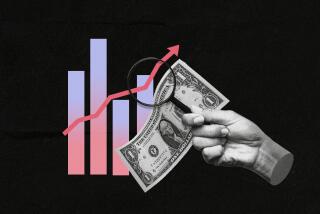Near-Retirees Don’t Have Enough Saved
- Share via
WASHINGTON — Despite the longest period of economic prosperity in American history, most older workers are less well-provisioned for retirement than they were when the growth began, according to a study released Thursday.
The study, by New York University economist Edward N. Wolff, concludes that more than 40% of households headed by workers nearing retirement--those 47 to 64 years old--don’t have enough to replace even half their pre-retirement income, up from less than 30% in the 1980s. Nearly 20% don’t have enough to keep themselves above the poverty line.
Most experts say people need to replace 75% to 80% of pre-retirement income to live comfortably after quitting work.
“We thought near-retirees would be far ahead of their predecessors” because of rising incomes and stock market gains, Wolff said. Instead, he said, “what we found is that most people had lost ground in the 1990s.”
Officials with the Economic Policy Institute, the labor-backed think tank that sponsored the study, said Wolff’s findings prove that Washington should resist conservative calls for privatizing Social Security and find ways to revive traditional, company-run pension plans as an alternative to individually controlled 401(k)s.
“The way we now go about providing for retirement just isn’t working for middle- and low-income Americans,” said Jeff Faux, the EPI’s president. “It’s time to stop talking about shifting Social Security money to private accounts and start talking about how we can make sure that working Americans will have adequate pensions that will enable them to live decently in retirement.”
However, a close look at Wolff’s study suggests that it offers as much ammunition to proponents of individual accounts and privatization as it does to opponents.
Among other things, it traces many of middle Americans’ retirement troubles to an erosion of Social Security and traditional pension wealth during the 1980s and 1990s and suggests that the decline would have been even greater had it not been offset by immense gains in 401(k) wealth.
“I’m not sure this study proves all the things its author thinks it proves,” said Andrew G. Biggs, an analyst with the libertarian Cato Institute in Washington.
Whatever the political spin, Wolff’s conclusions contradict the conventional wisdom that a large fraction of Americans in the middle and upper range of the nation’s economic pile are better prepared for retirement because of the boom of the 1980s and 1990s.
They seem likely to feed worries spurred by the stock crash, a recession and corporate debacles such as that of Enron Corp. that the good times of the 1990s may not have been quite as good--nor their benefits quite as enduring--as many thought only a few years ago.
“Clearly, there’s something going on here that reflects a growing financial anxiety among the middle class,” Faux said.
Wolff based his study on the Federal Reserve’s every-three-years Survey of Consumer Finances, which provides the most comprehensive look available at the wealth--including retirement wealth--of American households.
Among his findings:
* From 1989 to 1998, the last year he examined, the share of households whose projected retirement income is less than half their pre-retirement income rose from 29.9% to 42.5%. The news is even worse for African American and Latino households, which saw an increase to 52.7%.
* For households at the median or the middle of the nation’s economic pile, overall retirement wealth declined by 11% from 1983 to 1998.
* Only the very richest of near-retirees, those with a net worth of $1 million or more, saw their retirement wealth increase in that period. All other groups--even those with net worth between $500,000 and $1 million--saw a decline.
* The share of near-retirement households with non-Social Security retirement coverage climbed only 3.5 percentage points to 73.7% despite the proliferation of 401(k) plans. At least in part, that was because many people covered by traditional pensions at the start of the period traded their coverage for individual accounts.
* In what Wolff and EPI officials portrayed as the one bright spot in the retirement landscape, Social Security coverage became virtually universal, rising from 82.4% in 1983 to 98.4%.
Wolff said though 1998 was the last year he examined, his findings still are applicable. That’s because stock gains in 1999 and early 2000 largely have been erased.






